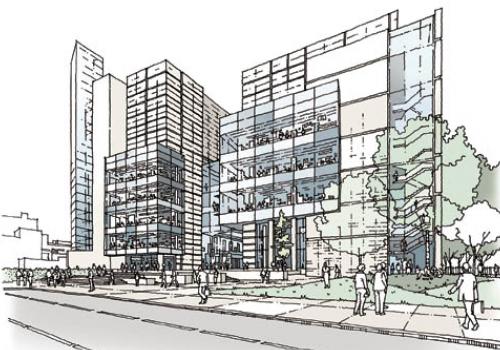Research centre hailed as ‘cathedral of science’

First view of £520m project but concerns about safety remain
ITS architect has called it a “cathedral of science”, and a Nobel laureate believes it will “safeguard the health of generations to come”.
Plans for the £520million medical research centre proposed for Somers Town were unveiled on Monday when biologist Sir Paul Nurse described it as the “most exciting project for UK biological science within a generation”.
The UK Centre for Medical Research and Innovation (UKCMRI) will open on land between Midland Road and Brill Place by 2015, according to a consortium made up of the Medical Research Council, the Wellcome Trust, Cancer Research UK and University College London.
The centre will host research which could lead to cures or better treatments for cancer, circulatory disease and viruses.
But however strong the scientific case for the centre, the consortium knows it needs to convince people in Somers Town and Camden it will be a good, safe neighbour.
Consultations with residents will begin on Friday, beginning months of negotiations which are likely to be hard-fought.
The first talks will be with Camden’s politicians and housing campaigners. A 2003 council planning brief earmarked at least half of the Brill Place site for housing. That remains official council policy – the Town Hall needs to find space for 10,000 new homes – but it will not be met by this development. Conservative, Lib Dem and Labour councillors lobbied the government to intervene to ensure housing was built on the site, but to no avail.
On Monday, UCL Provost Sir Malcolm Grant said the 2003 brief was designed for a potential commercial developer, and could not have envisaged the building of a research centre, which will provide education links, training and jobs in addition to its scientific work.
Professor Grant said: “We’re not doing a commercial development, we’re doing a development for public benefit. It is not our role to provide affordable housing. That doesn’t mean we are shutting our eyes to the needs of Somers Town... there will be jobs for local people in the construction phase, and there will be some priority for local people for jobs at the centre.”
The consortium owns the derelict National Temperance Hospital site in Hampstead Road. But hopes that this might be used for housing as part of a planning deal have been dismissed by the centre’s backers. “That site is going to be disposed of at an appropriate time,” said Medical Research Council chief executive Sir Leszek Borysiewicz.
Planning discussions will examine the building’s bulk and height. Although a third of the centre will be underground, it will rise to at least six storeys.
A second major question is over security and safety. Critics of the project questioned the wisdom of siting a building containing dangerous pathogens in a densely populated transport hub. Others, including senior council figures, wondered if the centre would be vulnerable to animal research extremists.
The centre’s scientists said on Monday that its containment facilities will be “high category three” – not the highest level. It will hold viruses like ’flu, but not the most virulent pathogens, such as ebola.
Higher-security containment facilities – category four – already exist elsewhere in central London.
Research on animals will take place at the centre, but “not work outside of rodents”, according to Sir Leszek, ruling out primate research.
UKCMRI chief executive John Cooper recognised the concerns over security. “We really are trying very hard not to have something that looks like Fort Knox,” he said. “There must be security, but we are hoping not to be hamstrung by high-security barriers. This is a new, state-of-the-art building, and the containment facilities are going to be bang up to date.”
Mr Cooper promised a sensitive, not-for-profit approach to the construction process. When completed, the centre would allow Camden schoolchildren and teachers to mix with the world’s leading scientists and use the best facilities, “improving the awareness of scientific issues and enthusing the next generation of scientists”.
PAUL KEILTHY




Comments
Post new comment